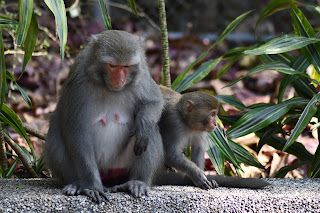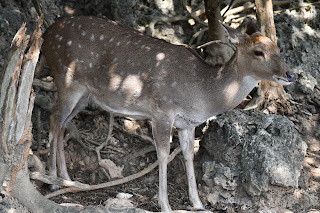Kaohsiung
I honestly
did not think I would manage to see as much as I did the previous day, leaving
me with much more time than I expected to explore Gaoxiong. I began the morning
by taking the metro down to the river. To be honest, I expected the riverside
to be a little more scenic, Gaoxiong being Taiwan’s number two city, but there
were some interesting buildings along the banks nonetheless. My first stop was
Holy Rosary Cathedral, widely renowned as Taiwan’s prettiest cathedral, and
also, technically, the oldest church in Taiwan (it was established in 1860, but
the primacy is a questionable one as the building was rebuilt to its current
dimensions in 1928). Unfortunately, the cathedral was closed, with a sign
outside the door saying that a mass was in progress. I resolved to return
later.
I walked
along the river towards the sea, where Gaoxiong’s port is located. Much of the
port is no longer in use, the abandoned warehouses having been converted into
shops, cafes, and art installations. To be sure, it is not as pleasant a
waterfront as the one in Tamsui, but it gives a true impression of the volume
of commerce that used to pulse through Gaoxiong during the city’s heyday.
A view of Gaoxiong's riverside
Another view of Gaoxiong's riverside
A view of Gaoxiong's new culture and music centre set to open this year
Holy Rosary Cathedral
Another view of the Holy Rosary Cathedral
Another view of the honeycomb-like cultural centre
Gaoxiong's abandoned warehouses, many of which have been converted into trendy businesses
An art installation made up of anchors
Another view of the same
Gaoxiong's current customs house
I am not sure what is transported in a car like this but it is very quaint
Somehow,
without really knowing what I was doing, I strolled right up to the ferry I had
hoped to find later on. To my luck, it was just about to depart. Only a few
minutes away from the mainland is a small island called Qijin Island, famous
for its fort, lighthouse, and the oldest temple in Gaoxiong. Unfortunately both
the temple and the lighthouse were under reconstruction, while the fort itself
was not particularly impressive. On the other hand, it did offer some nice
views of Gaoxiong. After maybe two hours of traversing the streets and beaches,
I caught another ferry back to the mainland.
The view of the old British consulate from the ferry to Qijin Island
"Cijin" corresponds to the Minnanese pronunciation of "Qijin"
A picturesque bike path runs along the coast of Qijin Island
The massive Presbyterian Church at Qijin
The seaside atmosphere took me aback after a long time of only travelling to cities
An alley on Qijin, with a view of a nearby ship
The Cihou Fort, constructed in the 1870s by the Qing
A lonely lighthouse jutting out into the sea
Tourists taking pictures of the Gaoxiong skyline
More of the Cihou Fort
The view of Shoushan park and western Gaoxiong from the Cihou Fort
Gaoxiong's famous 85 Sky Tower
A bridge shortening the walk between the ferry terminal and the westernmost part of Gaoxiong
The last
major item on my itinerary was the British consulate in Takao, which is perhaps
not as well curated as the consulate in Tamsui but has an interesting
exposition nonetheless. I thought it very topical that Turandot was playing on
the museum broadcasting system, but I later realised it was merely a CD of big
opera hits.
The Gaoxiong skyline as seen from western Gaoxiong
The old British Consulate at Gaoxiong
Another view of the consulate
Two views of the portico at the old British Consulate
Gaoxiong as seen from the old British Consulate
Another view of the Gaoxiong skyline
Some
difficulty ensued with getting to my next destination. I decided that the final
thing I wanted to see in Gaoxiong were the Formosan rock macaques in Shoushan
park. The trouble was that Shoushan park is enormous and I had no way of
knowing where the monkeys might be. Since I could not find the trail connecting
the consulate with Shoushan as depicted on my map, I walked down again from the
consulate, which stands atop a little hill, and – remembering that I had seen a
number of taxis parked outside the ferry station – took a cab from there.
I
instructed the driver to take me up to the Kaohsiung Martyr’s Shrine, which I
knew was in the general Shoushan area. The shrine, built to commemorate KMT
soldiers, was quite impressive, but there were no signs of monkeys anywhere in
the vicinity. I set off, therefore, along one of the roads leading to Gaoxiong
Zoo, having read that nearby was the beginning of a hiking trail that I might
ascend in the event of finding no monkeys along the way.
As I made
my way up and down the mountain slope, I not only happened upon a quite pretty
Buddhist temple, but also got rather sunburned. I had, stupidly, not shielded
myself with my umbrella, which I always carry around for that purpose (that is,
for the purpose of doubling as a parasol). Anyway, after an inordinate amount
of walking, I made it to the zoo’s entrance at around three o’clock, but had
not yet seen any monkeys. As I pondered what to do, and how I might get near
these elusive primates, I got a sign from heaven in the form of an announcement
through the zoo’s broadcasting system: a warning not to feed the feral monkeys,
who, the zoo assured its visitors, were not part of any of its own exhibits. Of
course, I bought my ticket right there and then.
It did not
take long to find the monkeys. I found that through holes in the outer fences,
they descended upon the zoo’s bins, which they ransacked for any little scrap
of food. As I stopped to take pictures of the furtive thieves, I had no idea
what pandemonium I would cause. Soon enough, other visitors began to notice the
monkeys too, and started throwing them bits of their own food. Both the group
of monkeys and the group of tourists grew until there were maybe two dozen in
each camp, one eagerly awaiting the nourishment of the other. Their showing up
was rewarded with fruit, as well as paper cups and various wrappers. Under the
encouragement of the tourists, the monkeys eventually picked apart the whole
bin, while the tourists supplied them with increasingly un-nutritious articles
in the hopes of retaining them. I decided it was best for me to leave.
I did not
pay much attention to anything at the zoo besides the exhibits containing Taiwan’s
indigenous wildlife. Among them were several Formosan sika deer (famous for the
once booming trade in deer skins), a Formosan serow (which we had seen during
our hike up Xueshan last year), a Formosan wild boar (previously completely
unknown to me as a species), and a Formosan black bear (the only large
carnivore species endemic to Taiwan after the Formosan clouded leopard went
extinct). As far as I could tell, the latter species were only represented by
one exemplar each, which seemed to have a negative effect on their mental
wellbeing. The bear kept walking around in circles, while the serow and boar
stood around dejectedly.
The Gaoxiong Martyrs' Shrine
Another view of the inner courtyard of the Gaoxiong Martyrs' Shrine
The Faxingchan temple, upon which I happened as I made my way across the mountain
A Formosan rock macaque anticipating being thrown a treat
The same Formosan rock macaque after receiving its treat
The same Formosan rock macaque eating what appears to be a sausage gifted by a Taiwanese tourist
Another Formosan rock macaque holding a cup it fished out from the garbage
An adult and a baby Formosan rock macaque on top of a bin
An adult and a baby Formosan rock macaque at the sidelines of the feast
A Formosan sika deer
A Formosan rock macaque eating some baked goods
The same Formosan sika deer
A Formosan rock macaque at the foot of a tree in the Formosan sika deer exhibit
A Formosan black bear pacing back and forth at the zoo
A lonely and dejected Formosan wild boar
A lonely and dejected Formosan serow
My
departure from the zoo, without any taxis in sight, began a long trek back to
the city. On the way down, I happened upon another temple that I had in fact
intended to visit but had relegated to the bottom of my priority list after
undergoing a temple-fatigue in Tainan. My feet were killing me, but I had to
make it to my last destination: the Holy Rosary Cathedral, which I hoped would
be open by now. To my great disappointment, it was not, the sign outside still
saying that a mass was in progress. Somewhat suspicious, I went to a nearby
restaurant from which I kept an eye on the church while finishing The
Outlaws of the Marsh, which I have been reading for about two months now.
After some forty minutes, I gave up waiting, having grown convinced that the
never-ending mass was simply a big con.
Yuan Heng Temple
The interior of Yuan Heng Temple
The exterior of the Holy Rosary Cathedral (once more)
The Qianjin District Presbyterian Church
I left
early in the morning the next day, having travelled to my heart's content and
desirous of some rest. Since I had finished reading my book, I was left with
nothing to do on the train but to look through my photos and work on these blog
posts.






















































Comments
Post a Comment